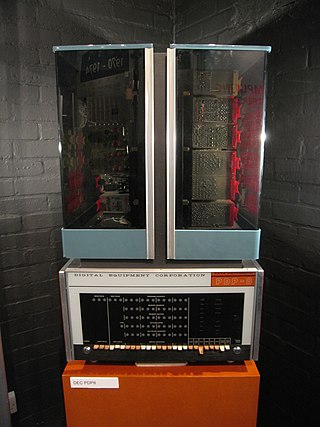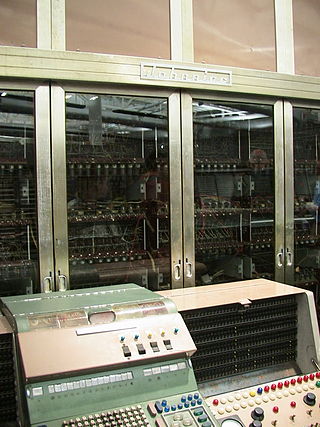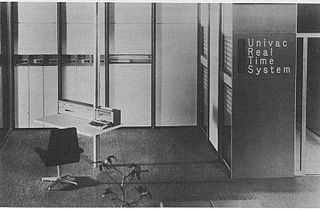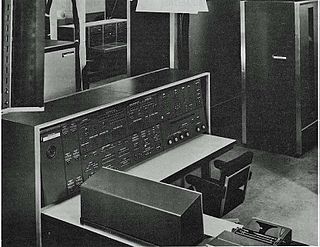
The Data General Nova is a series of 16-bit minicomputers released by the American company Data General. The Nova family was very popular in the 1970s and ultimately sold tens of thousands of units.

The PDP-8 is a family of 12-bit minicomputers that was produced by Digital Equipment Corporation (DEC). It was the first commercially successful minicomputer, with over 50,000 units being sold over the model's lifetime. Its basic design follows the pioneering LINC but has a smaller instruction set, which is an expanded version of the PDP-5 instruction set. Similar machines from DEC are the PDP-12 which is a modernized version of the PDP-8 and LINC concepts, and the PDP-14 industrial controller system.

The UNIVAC I was the first general-purpose electronic digital computer design for business application produced in the United States. It was designed principally by J. Presper Eckert and John Mauchly, the inventors of the ENIAC. Design work was started by their company, Eckert–Mauchly Computer Corporation (EMCC), and was completed after the company had been acquired by Remington Rand. In the years before successor models of the UNIVAC I appeared, the machine was simply known as "the UNIVAC".

The IBM 650 Magnetic Drum Data-Processing Machine is an early digital computer produced by IBM in the mid-1950s. It was the first mass-produced computer in the world. Almost 2,000 systems were produced, the last in 1962, and it was the first computer to make a meaningful profit. The first one was installed in late 1954 and it was the most popular computer of the 1950s.

UNIVAC was a line of electronic digital stored-program computers starting with the products of the Eckert–Mauchly Computer Corporation. Later the name was applied to a division of the Remington Rand company and successor organizations.

The JOHNNIAC was an early computer built by the RAND Corporation and based on the von Neumann architecture that had been pioneered on the IAS machine. It was named in honor of von Neumann, short for John von NeumannNumerical Integrator and Automatic Computer.
The AN/USQ-17 or Naval Tactical Data System (NTDS) computer referred to in Sperry Rand documents as the Univac M-460, was Seymour Cray's last design for UNIVAC. UNIVAC later released a commercial version, the UNIVAC 490. That system was later upgraded to a multiprocessor configuration as the 494.

The UNIVAC 1100/2200 series is a series of compatible 36-bit computer systems, beginning with the UNIVAC 1107 in 1962, initially made by Sperry Rand. The series continues to be supported today by Unisys Corporation as the ClearPath Dorado Series. The solid-state 1107 model number was in the same sequence as the earlier vacuum-tube computers, but the early computers were not compatible with their solid-state successors.

The history of computing hardware starting at 1960 is marked by the conversion from vacuum tube to solid-state devices such as transistors and then integrated circuit (IC) chips. Around 1953 to 1959, discrete transistors started being considered sufficiently reliable and economical that they made further vacuum tube computers uncompetitive. Metal–oxide–semiconductor (MOS) large-scale integration (LSI) technology subsequently led to the development of semiconductor memory in the mid-to-late 1960s and then the microprocessor in the early 1970s. This led to primary computer memory moving away from magnetic-core memory devices to solid-state static and dynamic semiconductor memory, which greatly reduced the cost, size, and power consumption of computers. These advances led to the miniaturized personal computer (PC) in the 1970s, starting with home computers and desktop computers, followed by laptops and then mobile computers over the next several decades.

The UNIVAC 490 was a 30-bit word magnetic-core memory machine with 16K or 32K words; 4.8 microsecond cycle time made by UNIVAC. It was a commercial derivative of the instruction set that had been developed for the AN/USQ-17 by Seymour Cray for the US Navy. This was the last machine that Cray designed before leaving UNIVAC to join the early Control Data Corporation.

The UNIVAC LARC, short for the Livermore Advanced Research Computer, is a mainframe computer designed to a requirement published by Edward Teller in order to run hydrodynamic simulations for nuclear weapon design. It was one of the earliest supercomputers.

The HP 2100 is a series of 16-bit minicomputers that were produced by Hewlett-Packard (HP) from the mid-1960s to early 1990s. Tens of thousands of machines in the series were sold over its twenty-five year lifetime, making HP the fourth largest minicomputer vendor during the 1970s.
The UNIVAC III, designed as an improved transistorized replacement for the vacuum tube UNIVAC I and UNIVAC II computers, was introduced in June 1962, with Westinghouse agreeing to furnish system programing and marketing on June 1, 1962. It was designed to be compatible for all data formats. However the word size and instruction set were completely different; this presented significant difficulty as all programs had to be rewritten, so many customers switched to different vendors instead of upgrading existing UNIVACs.
The UNIVAC 418 was a transistorized, 18-bit word magnetic-core memory machine made by Sperry Univac. The name came from its 4-microsecond memory cycle time and 18-bit word. The assembly language for this class of computers was TRIM III and ART418.

The UNIVAC II computer was an improvement to the UNIVAC I that the UNIVAC division of Sperry Rand first delivered in 1958. The improvements included the expansion of core memory from 2,000 to 10,000 words; UNISERVO II tape drives, which could use either the old UNIVAC I metal tapes or the new PET tapes; and some transistorized circuits. It was fully compatible with existing UNIVAC I programs for both code and data. It weighed about 16,000 pounds.

The CDC 1604 is a 48-bit computer designed and manufactured by Seymour Cray and his team at the Control Data Corporation (CDC). The 1604 is known as one of the first commercially successful transistorized computers. Legend has it that the 1604 designation was chosen by adding CDC's first street address to Cray's former project, the ERA-UNIVAC 1103.

The CDC 6000 series is a discontinued family of mainframe computers manufactured by Control Data Corporation in the 1960s. It consisted of the CDC 6200, CDC 6300, CDC 6400, CDC 6500, CDC 6600 and CDC 6700 computers, which were all extremely rapid and efficient for their time. Each is a large, solid-state, general-purpose, digital computer that performs scientific and business data processing as well as multiprogramming, multiprocessing, Remote Job Entry, time-sharing, and data management tasks under the control of the operating system called SCOPE. By 1970 there also was a time-sharing oriented operating system named KRONOS. They were part of the first generation of supercomputers. The 6600 was the flagship of Control Data's 6000 series.

The NCR 315 Data Processing System, released in January 1962 by NCR, is a second-generation computer. All printed circuit boards use resistor–transistor logic (RTL) to create the various logic elements. It uses 12-bit slab memory structure using magnetic-core memory. The instructions can use a memory slab as either two 6-bit alphanumeric characters or as three 4-bit BCD digits. Basic memory is 5000 "slabs" of handmade core memory, which is expandable to a maximum of 40,000 slabs in four refrigerator-size cabinets. The main processor includes three cabinets and a console section that houses the power supply, keyboard, output writer, and a panel with lights that indicate the current status of the program counter, registers, arithmetic accumulator, and system errors. Input/Output is by direct parallel connections to each type of peripheral through a two-cable bundle with 1-inch-thick cables. Some devices like magnetic tape and the CRAM are daisy-chained to allow multiple drives to be connected.

The Honeywell 316 was a popular 16-bit minicomputer built by Honeywell starting in 1969. It is part of the Series 16, which includes the Models 116, 316 (1969), 416 (1966), 516 (1966) and DDP-716 (1969). They were commonly used for data acquisition and control, remote message concentration, clinical laboratory systems, Remote Job Entry and time-sharing. The Series-16 computers are all based on the DDP-116 designed by Gardner Hendrie at Computer Control Company, Inc. (3C) in 1964.
Ferranti's Sirius was a minicomputer released in 1961. Designed to be used in smaller offices without a dedicated programming staff, the Sirius used decimal arithmetic instead of binary, supported Autocode to ease programming, was designed to fit behind a standard office desk, and ran on UK standard mains electricity with no need for cooling. It was also fairly slow, with instruction speeds around 4,000 operations per second, and had limited main memory based on delay lines, but as Ferranti pointed out, its price/performance ratio was difficult to beat.















